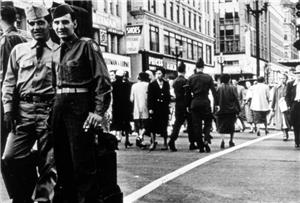In February 1943, operators of tattoo parlors in Seattle note that patriotic designs are the most popular form of body art among the many servicemen now visiting the city. Since the U.S. Navy has recently barred depictions of unclad figures, there is a brisk business in drawing clothing onto nude figures previously tattooed on the bodies of military personnel.
Changes in tattoo business noted due to Navy regulation in February 1943.
- By David Wilma
- Posted 1/03/2001
- HistoryLink.org Essay 2919
Sources:
James R. Warren, The War Years: A Chronicle of Washington State in World War II (Seattle: History Ink, 2000), 45.
Licensing: This essay is licensed under a Creative Commons license that encourages reproduction with attribution. Credit should be given to both HistoryLink.org and to the author, and sources must be included with any reproduction. Click the icon for more info. Please note that this Creative Commons license applies to text only, and not to images. For more information regarding individual photos or images, please contact the source noted in the image credit.

